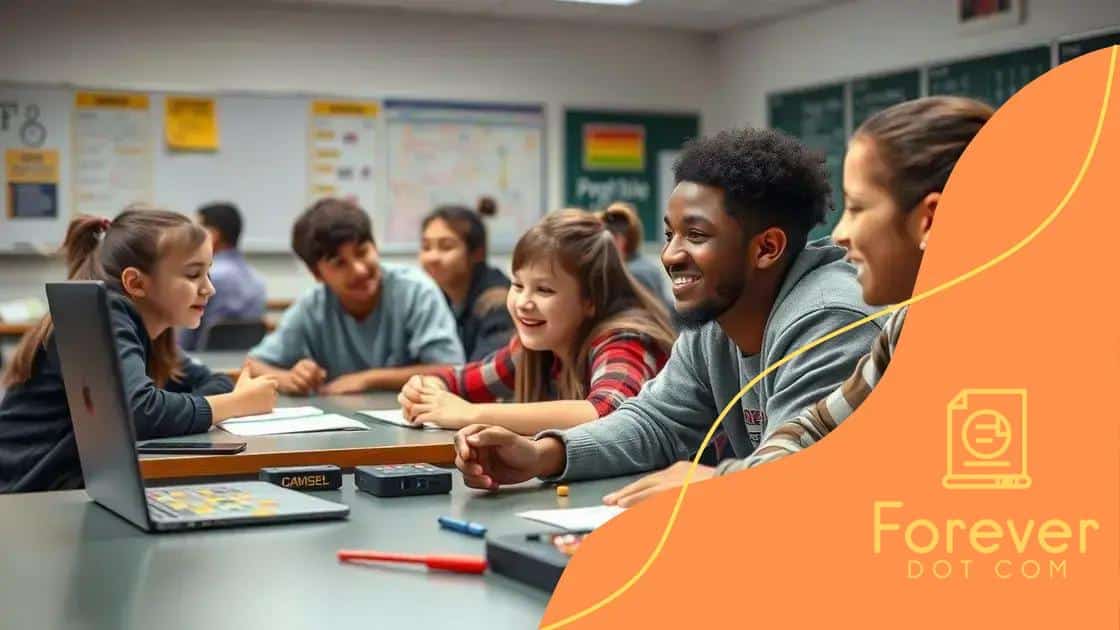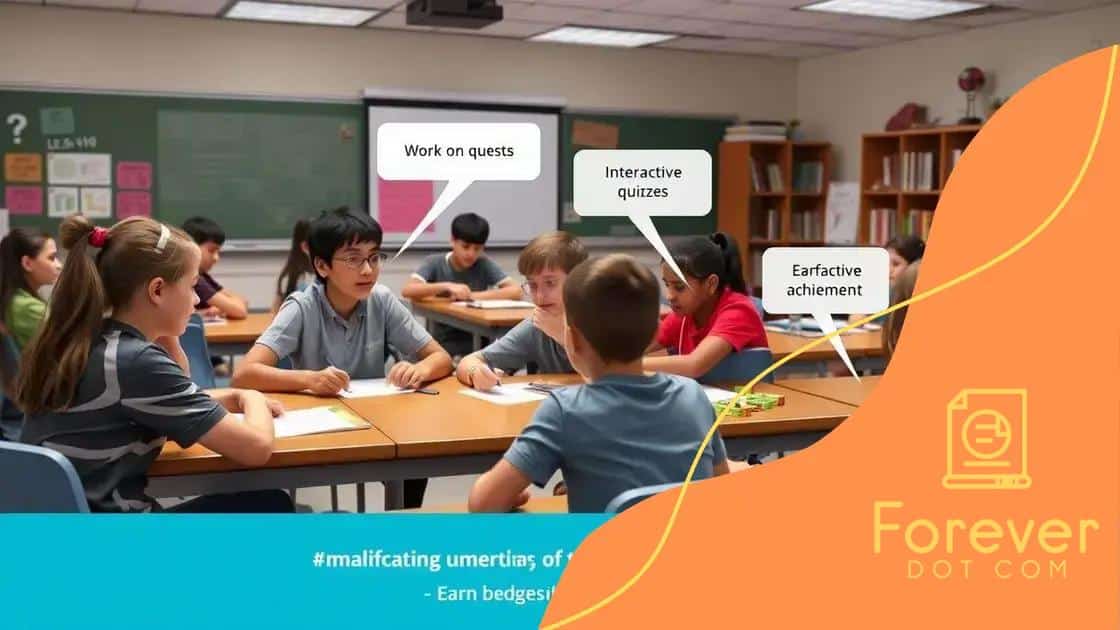How gamification is enhancing student learning experiences

Gamification enhances student learning experiences by incorporating game elements that boost motivation, engagement, and collaboration, leading to improved academic outcomes and a more dynamic educational environment.
How gamification is enhancing student learning experiences is not just a trend; it’s reshaping how students interact with their education. By incorporating game-like elements, educators can spark enthusiasm and motivation, making learning feel less like a chore. Ever thought about how this could change your classroom experience?
Understanding gamification in education
Understanding gamification in education is crucial for educators looking to enhance student engagement. Gamification uses game elements like points, rewards, and challenges to motivate learners. It creates an interactive environment that encourages participation.
What is Gamification?
Gamification is the application of game-design elements in non-game contexts. In the classroom, it transforms traditional learning by integrating competition and fun. Rather than viewing learning as a series of tasks, students see it as a game where they can earn rewards.
Key Elements of Gamification
- Points: Students earn points for completing tasks, motivating them to achieve goals.
- Badges: Badges provide recognition for accomplishments, boosting confidence.
- Leaderboards: These foster friendly competition and encourage students to improve.
By incorporating these elements, students become active participants in their learning. They experience a sense of achievement that traditional methods may not provide.
This method not only makes learning more enjoyable but also effective. When students are engaged and motivated, they are more likely to retain information and develop skills. Gamification can cater to different learning styles, making it an inclusive approach.
Examples in Practice
Many educators use gamification successfully in their classrooms. For instance, teachers might create a classroom quest where students earn points for collaborative projects or homework completion. This approach encourages teamwork and accountability among peers.
Furthermore, gaming apps and platforms, such as Kahoot! and Classcraft, facilitate gamification by allowing teachers to create quizzes and challenges. These tools make learning interactive and fun.
As students navigate through these gamified experiences, they gain essential skills such as problem-solving and teamwork. Gamification fosters a love of learning, paving the way for lifelong learners who are eager to explore new subjects.
The psychological benefits of gamification
The psychological benefits of gamification are significant, influencing how students engage with learning. By using game-like elements, education becomes less daunting and more exciting. This shift can drastically improve a student’s motivation and overall learning experience.
Increased Motivation
One of the primary psychological benefits is increased motivation. When students are rewarded for their efforts through points or badges, they feel a sense of accomplishment. This can lead to an intrinsic desire to learn and perform better.
Enhanced Engagement
- Active Participation: Gamification encourages students to actively engage in lessons.
- Reduced Apathy: Students become less apathetic towards learning.
- Fun Learning Environment: The incorporation of games makes learning enjoyable.
As students encounter challenges in a gamified environment, they gain confidence in their abilities. They are less afraid to make mistakes and more willing to try again. This resilience is crucial for lifelong learning. Furthermore, non-competitive elements of gamification foster collaboration rather than competition, creating a supportive learning community.
Gamification also taps into the students’ natural desire for achievement. As they progress through levels or complete missions, they feel a sense of purpose, making them more invested in their education. This journey not only makes learning enjoyable but also deeply rewarding.
Building Social Skills
Another psychological benefit of gamification is its ability to build social skills. Many gamified activities require teamwork, helping students develop communication and leadership skills. Through collaboration, students learn to respect diverse opinions and work together towards common goals.
In this way, gamification transforms learning into an interactive social experience. By leveraging technology and gaming principles, educators can create an environment where students thrive emotionally and intellectually.
Examples of gamification in classrooms

Examples of gamification in classrooms showcase innovative ways to engage students and enhance their learning experiences. Educators across the globe implement gamified elements to make lessons interactive and enjoyable.
Classroom Quests
One popular example is the implementation of classroom quests. Teachers can create challenges where students earn points for completing specific tasks or assignments. This method encourages collaboration and teamwork as students work together to overcome challenges.
Interactive Quizzes
- Kahoot!: This game-based learning platform allows teachers to create fun quizzes that students can answer in real-time.
- Quizizz: Similar to Kahoot!, it incorporates leaderboards and fun rewards to motivate students.
- Google Forms: Teachers can create engaging quizzes with immediate feedback to keep students engaged.
These interactive tools transform traditional assessments into exciting competitions, keeping studentsfocused and motivated. As students compete for top scores, the learning becomes more dynamic and memorable.
Another effective example is integrating role-playing games (RPGs) into lessons. In this approach, students can take on different characters, exploring various scenarios and making decisions that impact the storyline. This not only makes learning enjoyable but also encourages critical thinking and creativity.
Badges and Rewards
Many educators use badges and rewards to celebrate accomplishments. Students can earn digital badges for reaching milestones, completing projects, or mastering specific skills. This recognition boosts their confidence and provides a clear sense of progress.
Additionally, gamification can involve physical activities, such as movement-based learning. For instance, teachers can create scavenger hunts where students move around the classroom or school to discover clues related to the lesson. This approach keeps students engaged both mentally and physically.
By incorporating gamified strategies, teachers can transform their classrooms into vibrant learning environments where students are motivated to explore, collaborate, and succeed.
Strategies for effective gamification
Strategies for effective gamification are essential for teachers to create engaging learning environments. To implement gamification successfully, educators need to consider a variety of approaches that resonate with students.
Set Clear Objectives
First, it’s important to set clear objectives for gamified activities. Students need to understand what they are expected to learn and how they can achieve success. By establishing goals, educators can keep students focused and motivated throughout their learning journey.
Incorporate Feedback
- Immediate Feedback: Providing instant feedback helps students understand their progress and areas for improvement.
- Celebrating Achievements: Acknowledging milestones or accomplishments reinforces positive behavior.
- Encouraging Reflection: Allow time for students to reflect on what they learned during the gamified activities.
Feedback encourages students to engage more deeply with the content and promotes a growth mindset. As they see their progress in real-time, their motivation to learn increases.
Creating a narrative or storyline can also enhance the gamified experience. A compelling story can immerse students in the learning process, making them feel part of an adventure. For example, a science lesson could be framed as a mission to save an endangered species, sparking interest and excitement.
Utilize Diverse Game Elements
Using a variety of game elements is key to maintaining interest. Educators can mix rewards, challenges, and competitions to appeal to different student preferences. Incorporating elements like badges, levels, and leaderboards allows students to engage in different ways.
Creating collaborative tasks can further promote teamwork and social interaction among students. Cooperative challenges allow students to work together towards a common goal, leading to deeper connections and learning experiences.
Gamification should be used thoughtfully. It’s important to ensure that game elements support learning objectives rather than distract from them. By carefully integrating these strategies, educators can create a balanced and effective gamified classroom environment.
Measuring the impact of gamification on learning
Measuring the impact of gamification on learning is essential to understand its effectiveness in educational settings. By evaluating various factors, educators can identify the strengths and areas for improvement in their gamified approaches.
Assessment Methods
One effective way to measure impact is through assessments. Pre-tests and post-tests can provide valuable insights into knowledge gained before and after gamified activities. By comparing scores, teachers can evaluate how well students understood the material and retained the information.
Engagement Metrics
- Participation Rates: Tracking how many students actively engage in gamified activities gives insight into their level of interest.
- Time on Task: Monitoring the amount of time spent on learning tasks can indicate whether gamification is keeping students focused.
- Behavioral Observations: Observing student interactions and enthusiasm during gamified lessons can provide qualitative data.
These engagement metrics help educators assess whether gamification motivates students and enhances their learning experiences.
Feedback from students is another crucial element in measuring the impact of gamification. Surveys and discussions can reveal how students feel about gamified lessons. Understanding their perspectives helps teachers identify which elements work best and which may need adjustments.
Longitudinal Studies
Conducting longitudinal studies can provide deeper insights into the long-term effects of gamification. By following a group of students over time, educators can analyze trends in performance and engagement. This approach can highlight whether gamification leads to sustained improvements in learning outcomes.
Finally, comparing gamified and traditional learning methods can shed light on the effectiveness of gamification. By analyzing outcomes from these two approaches, educators can make informed decisions about their teaching strategies. If gamified methods yield better results, it underscores the value of incorporating game elements into education.
FAQ – Frequently Asked Questions about Gamification in Education
What is gamification in education?
Gamification in education involves using game elements in learning activities to increase student engagement and motivation.
How does gamification enhance student learning?
Gamification enhances learning by making it fun and interactive, encouraging students to participate actively and collaborate with peers.
What are some examples of gamification strategies?
Examples include classroom quests, interactive quizzes, earning badges, and using role-playing games to teach concepts.
How can teachers measure the impact of gamification?
Teachers can measure impact through assessments, engagement metrics, feedback from students, and comparing outcomes between gamified and traditional learning methods.






